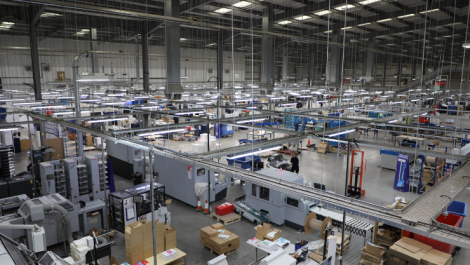There was a time when the difficulties involved in arranging finance for buying software could put many printers off. Nowadays though, reports Andy Knaggs, lenders are much happier to talk business.
Ten years ago, the world was a very different place to the one we live in today: there was no such thing as ordering an Uber on your smartphone; your smartphone was not really that smart; and Donald Trump was just a rich businessman with a TV show and a handful of golf courses. There was also the possibility that if you approached a lender looking for finance to buy software, you might be laughed out of the room.
Much has changed since then, and the prospects of walking out of the bank with a deal for software is now very much better. According to Luke Mulligan, sales executive at Sheppex Asset Finance, this is partly due to a much more widespread view that software can bring tangible benefits to a business.
‘In 2008, there were a lot of limitations on what banks would lend for. Since then, software has become more common everywhere, and banks are keen to support business growth,’ he said. ‘Software is seen as a viable option to improve a business, and increase turnover and profit margin. It’s not just replacing a piece of kit; with software you can see that growth in the business from when you made that investment.
‘Now, many of the banks have an appetite for this and companies see it as a viable option to improve their production speeds, generate more business and concentrate on getting more work through the doors.’
A traditional view
If there is a more enlightened view of software among the lending community nowadays, it is also true that not every institution is particularly interested in such deals. Some lenders still want the security of a hardware asset that will retain some residual value.
Close Brothers Asset Finance, for example, has a more traditional view. Paul Philbrick, sales director for the firm’s print division, explained that the software it has typically financed in the past has been as part of a bigger overall investment, normally including other assets.
‘We’ve tended to help our customers by looking to refinance more secure assets. This is because it’s traditionally given them access to more affordable funding with better terms – software finance is historically more expensive as it’s typically unsecured,’ he commented.
That said, Mr Philbrick adds that if printers are thinking about getting finance for a software deal, they should still approach Close Brothers, as it ‘can make something happen’. However, if you’re not sure who to approach, who might say yes and who might say no, then Katie Dowse of Clear Asset Finance says she can help.
‘We know the funders who do or don’t finance software. All the ‘Tier 1’ such as Investec will do software, with an element of training and services included as well, because they know that comes with it. They are very automated, and it’s based on the ability to pay. The more traditional funders don’t – they are more asset and residual value-based funders. High street banks will give you a loan for it but that’s not the most sensible way to do it.
‘We will try to find the finance for them. We view it like any other asset, it’s as simple as that.’
The pity is that many printing companies are unaware that they do not have to pay cash or use a finance deal from the software vendor itself to make a big software acquisition, says Ms Dowse. This lack of awareness can lead to limitations being imposed on the scale of the software purchase, or even in the idea being scrapped altogether.
‘Don’t restrict your vision of what you want software to do because you think you need to pay cash and you can’t afford the implementation you want. You really need to think about how you will use the software, and commit to using it, otherwise it’s all a waste of time. If it means paying for another week’s training, then that’s part of it.’
It also requires some careful thinking about the overall impact of a big software implementation on the business, she said: ‘You’ve got to look at the return on investment, just like you would with a new press. You have to consider that if you are going to invest in software you are not purely buying software – it’s also about the training and support that that company will give you.
‘There’s sometimes an under-spend on software, rather than looking at the whole investment strategy, which could include some downtime while the training is going on. You might have paid £40,000 for it and then you don’t really use the software because no-one really knows how to use it. Look at that whole situation and take the time to make the right decision. Get the right company with good technical support and training and make sure you buy enough licences. I’ve heard of situations where people have said, we can only pay cash, we will only get three licences, when they really needed more.’
 Compare the market
Compare the market
Mark Nelson of Compass Business Finance agrees that requests for finance deals to buy software and other unsecured items that have no resale value are becoming more prevalent in the market, and he also offers some advice on how to approach the situation.
‘If the supplier of the software offers you finance, be sure to check it is competitive in the market – some will be, but some will be extortionately expensive. Also, look at a couple of options, ensuring one has multiple sources of finance, rather than just the business they work for – this allows for a large transaction to be split into smaller, more manageable sizes, thus reducing the size of the risk to each finance company.’
Will any security or personal guarantees be required? Possibly, says Luke Mulligan of Sheppex, although he stresses that every deal is assessed on its own merits. ‘Most of the businesses we work with in the print sector are SMEs, and it may be necessary to take a personal guarantee with that type of business if the balance sheet does not support the lending,’ he said. ‘We would look at year-end accounts and bank statements to get an understanding of the company’s financial standing. We need to ensure that the purchase is affordable and will benefit their business, and we would look to underwrite a deal without a personal guarantee if we can see that the software will improve the business.’
Mr Mulligan advised getting good information from the software vendor – information such as the benefits the implementation will bring to the business, the reduced production costs, the increased margins, the monthly savings it will accrue – to smooth the path to securing a successful finance deal.
‘Get the financial indicative costing in place. If the finance costs £500 per month and the production gain is £1000 per month, it’s a no-brainer,’ he added. ‘If the business has been trading for years, has got a good balance sheet, and the software will help grow the business, there’s a view that the business will be able to afford it.’
Judging by the experience of Compass, Clear and Sheppex, printers are approaching brokers looking for software deals with increasing regularity, even at a time when there are numerous subscription and Cloud-based models for licencing software. ‘There’s still usually an initial cost, and we are often financing that initial cost,’ said Luke Mulligan.
The message really is that big software purchases can be made easier for a printing company by exploring different options for finance. The beneficial impact of software on a business’s efficiency is well accepted in today’s market, and many lenders are willing to look at these deals now by assessing the strength of the company’s financial footing. There is also no need to impose unnecessary limitations on the scale of a software implementation because of cash restraints. The decision can then be about business need, future scoping and return on investment.





